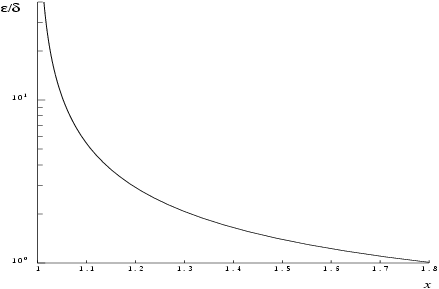nag_specfun_arccosh (s11ac) calculates an approximate value for the inverse hyperbolic cosine,
. It is based on the relation
This form is used directly for
, where
, and the machine uses approximately
decimal place arithmetic.
For
,
is equal to
to within the accuracy of the machine and hence we can guard against premature overflow and, without loss of accuracy, calculate
None.
If
and
are the relative errors in the argument and result respectively, then in principle
That is the relative error in the argument is amplified by a factor at least
in the result. The equality should apply if
is greater than the
machine precision (
due to data errors etc.) but if
is simply a result of round-off in the machine representation it is possible that an extra figure may be lost in internal calculation and round-off. The behaviour of the amplification factor is shown in the following graph:
Figure 1
It should be noted that for
the factor is always less than
. For large
we have the absolute error
in the result, in principle, given by
This means that eventually accuracy is limited by
machine precision. More significantly for
close to
,
, the above analysis becomes inapplicable due to the fact that both function and argument are bounded,
,
. In this region we have
That is, there will be approximately half as many decimal places correct in the result as there were correct figures in the argument.
None.
function s11ac_example
fprintf('s11ac example results\n\n');
x = [1 2 5 10];
n = size(x,2);
result = x;
for j=1:n
[result(j), ifail] = s11ac(x(j));
end
disp(' x arccosh(x)');
fprintf('%12.3e%12.3e\n',[x; result]);

